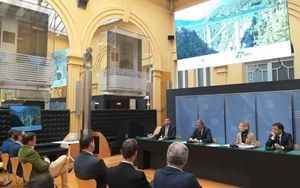(Finance) – The realization of the variant of Val di Riga, a 3.8-kilometre railway link between Sciaves and the Brenner line is getting closer and closer: once the agreement has been reached between the Autonomous Province of Bolzano represented by president Arno Kompatscher and the Extraordinary Government Commissioner and Deputy General Manager for Standards and Development of the Italian Railway Network (FS Group), Paola Firmi. The commissioner was thus able to issue the order approving the definitive project. The works will begin in the summer of 2023. The total economic investment of the project is approximately 200 million euros, also financed with PNRR funds.
Also present at the signing were theprovincial councilor for mobility, Daniel Alfredider, the RFI representative, Giuseppe Romeo, the president of the Association of Municipalities and mayor of Varna, Andreas Schatzer, the president of the District, Walter Baumgartner and the mayor of Naz Sciaves, Alexander Überbacher, as well as the head of STA, Martin Vallazza, director of Transport Structures Alto Adige Spa, Joachim Dejaco, and the director of the BBT Observatory, Martin Ausserdorfer.
“The objective of our mobility policy has always been to adapt public transport services to the needs of citizens” he underlined Compatscher. According to the president of the Autonomous Province of Bolzano this includes, for example, the reduction of travel times and a strictly scheduled timetable. “The construction of the Val di Riga railway variant – said Kompatscher – is one of the largest and most important infrastructure investments for mobility in South Tyrol and is exactly the right investment at the right time to sustainably and significantly improve the offer and service for citizens”.
“The approval of the definitive project of the Val di Riga variant is a decisive step forward for the realization of this important work which will directly connect the San Candido-Fortezza line to the Verona-Brennero line, between Rio Pusteria and Bressanone – he declared Sign –. The activation of this new railway link, in addition to allowing to achieve a significant reduction in travel times between Bressanone and Rio Pusteria, is part of the infrastructures functional to the achievement of the strategic objectives of development of the transport offer in the area and is part of the works foreseen in the context of the Italian candidacy for the Milan-Cortina 2026 Olympics”.
“Thanks to the new infrastructure, passengers will gain 17 minutes of time, will have a greater number of journeys available and will no longer have to change trains on the route from Bolzano to Val Pusteria” he declared alfreider summarizing the main benefits for passengers. With the construction of the Val di Riga railway variant, the Val Pusteria line will be connected directly to the Bressanone station. The provincial councilor for Mobility added that the new work will allow for 15-minute rides between Bolzano and the Brenner Pass and direct connections between Bolzano and the Val Pusteria every 30 minutes. With the two new stops in Varna and Naz-Sciaves, even more people will have access to train services, stressed Alfreider. Together with other railway projects in other parts of the Province, this work will allow for the creation of a timetable at regular intervals: in other words, even more coordinated journeys according to a fixed rhythm.
To coordinate the project, there were previously numerous meetings with the company STA – Strutture Trasporto Alto Adige SpA, which coordinates the project, with RFI and, among others, with the district communities of Val d’Isarco and Val Pusteria and the Municipalities of Varna and Naz-Sciaves.
There railway variant of Val di Riga, almost four kilometers long, passes under the A22 Brennero motorway and the Brennero state road in an 800-metre long tunnel, crosses the Isarco river with a 172-metre long arched bridge, runs alongside the Val Pusteria state road (SS 49bis) for over a kilometer and then connects with a 350-metre long tunnel and the new Naz-Sciaves stop to the existing railway line.
